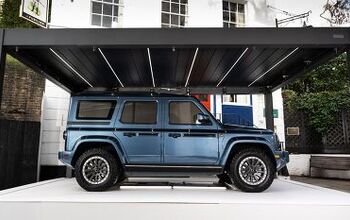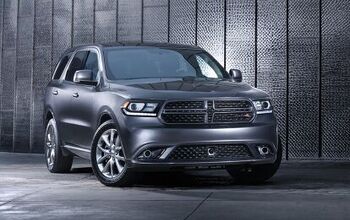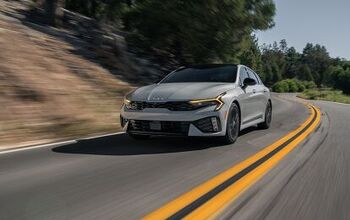Review: 2014 Accord EX-L Sedan CVT

Earlier this year, the most important car purchase question in human history was answered by a Accord EX-L V6 Coupe with six-speed manual transmission. Having cleared the 6000-mile mark in said coupe and having put everything from a wheelchair to a Rainsong JM-1000 to a BMX bike in the trunk in the past four months, I’ve learned a lot about the Modern Steel two-door. At some point, I’ll sit down and write up a long-term report.
Today, however, we have an Accord of a different feather. The trim designation is the same: EX-L. The engine, transmission, and body are all from the other half of Honda’s all-too-frequently binary choice matrix, however. A 125-mile trip in a mix of local and freeway conditions gave me the chance to answer the question: What’s the Accord like in a configuration that normal people actually buy?
Our test car was loaned to me for a rather quixotic mission involving Volkswagen replacement parts. For a destination-included MSRP of $29,070 against my Coupe’s $31,415, you get a choice of eight exterior and two interior colors. This one was “Champagne Metallic” with the beige interior. With just over 8,000 miles on the clock, it made for a very appropriate comparison with my Coupe.
In exchange for parting with about twenty-three hundred fewer dollars, you get:
- An extra set of doors and a longer wheelbase
- Seven cubic feet more passenger space and five inches more rear legroom
- The 2.4L, 185-horsepower EarthDreams inline four
- A continuously variable transmission
- No Homelink, but you do get an auto-dimming rearview mirror
- Power passenger seat
- Deletion of the LED running lamps
- Seventeen-inch wheels instead of eighteen-inch ones
- A forty-pound weight savings
The four-cylinder/CVT combo is, by far, the most popular Accord, and this is the nicest way to get it in the United States.
Stress and nervous tension are now serious social problems in all parts of the Galaxy, and it is in order that this situation should not be in any way exacerbated that the following facts will now be revealed in advance.
Honda has the CVT thing totally dialed.
Unless you’re a disaffected middle-aged man who is basically 50% Hank Moody and 50% a post-Minute by Minute Michael McDonald, the four-cylinder is more than powerful enough and it returns economy the six can’t think about touching.
In all other respects, the Accord continues its reign as America’s best mid-sized sedan, a reign that was horrifyingly interrupted by the chunky eighth-generation mistake-mobile but otherwise stretches back at least as far as 1982.
Okay. Feel better now? I certainly do. Let’s start with all the things this Accord sedan does very well, for those of you who have no experience with the 2013-up model: The beltline is lower than it is in any of the competition, sightlines are better, there is an airy, light feel to the cabin that cannot be had for love nor money anywhere else in the segment. You can argue that the Fusion, in certain trim levels, imparts a more convincing premium feel both in its interior aesthetic and the Germanic, lead-lined way it smothers external interruptions from noise to big bumps.
The Accord’s rear seat is simply enormous in precisely the same way that the Malibu’s is not. While in Las Vegas recently I saw a few of these in taxi service. You’d be lucky to get one; it’s spacious in all respects. The two-tone black-and-cream interior of our test sedan isn’t quite as convincing as the all-black interior of the V6 coupe is; if you want a top-notch light-colored cabin, you have to spend more money on the effort than Honda’s willing to do. This is where the Accord falls tangibly short compared to something like an Audi A4, but that will be small consolation to the German entry-luxury buyer who finds that the big Honda makes more friends on couples’ date nights.
All of that matters less in a market like ours where cars are owner-driven and frequently occupied by a single person. The Accord made headway in the Seventies as a dynamic proposition, a little low-cowled race car in a vast field of 204-inch personal luxury coupes. It was so good at replacing those bigger American cars that it eventually became a bigger American car. (See: “The Descolada”, Speaker For The Dead by Card, Orson Scott.) In a perfect world, the 2014 Accord would combine the thrift of the 1976 original with the effortless thrust of a 403-powered ’77 Cutlass Supreme Brougham.
Amazingly, it sort of does. Your humble author was impressed by the way Nissan used the CVT to make the Altima 2.5 acceptably quick, but trust me: compared to the CVT in this Accord, that Nissan was about as sophisticated as an episode of Friends. This one does the business. Around town, it responds to the typical half-throttle-in-a-mild-hurry by letting the engine rev immediately to 3500 or so, at which point it allows the revs to slowly creep as the ratio unwinds. The impression thus created, that of an engine accelerating mildly while the car sprints along, is exactly why people used to buy a big-block and pair it to a 2.73 axle ratio. Simply brilliant.
Once on the freeway, the four-cylinder Accord pulls a trick the six can’t touch: it drops the revs to a mildly astounding 1950 or so at eighty miles per hour, keeping the 2.4-liter on the very edge of lugging along. The result: over the course of seventy-plus fast freeway miles, the EX-L reported 36.4mpg. In the same conditions, my Coupe wobbles between 29.0 and 31.0. That’s outstanding economy that works in the real world. “Do you ever check the fuel economy?” I asked the car’s owner.
“I don’t know how,” was the response. So I pulled up the screen in question:
Consistent 30-plus, in mostly urban driving, with someone who couldn’t care less about economy behind the wheel. In those same circumstances, the V6 Coupe is lucky to return 25. (My Audi S5, just to put this in perspective, would return between twelve and fourteen miles per gallon when driven the same places in the same way.)
When it’s time to accelerate for a pass or to facilitate a merge, the Accord simply swings the ratio high again and provides near-instantaneous acceleration. It fairly leaps for the fabled 100mph mark and just as quickly drops the revs into the basement when the throttle is eased out again. How could you want any more powertrain than this, in the real world? Alas, but the four-cylinder isn’t likely to be nearly as magic without the rubber band transmission, and in any event it fails to deliver the VTEC rush of the single-overhead-cam six.
It’s common among the journalists to praise the four-cylinder variants of midsized sedans for their superior balance and scale-friendly GVWR. In Accordland, there’s barely any weight penalty for choosing the faster coupe. A few pounds on the nose is it and in daily use you wouldn’t be able to tell which engine your car had if you weren’t allowed to floor the throttle. Still, it’s easy to see why the six doesn’t account for many Accord sales. Indeed, the true question is why Honda doesn’t offer the loaded Touring model as a four-cylinder here, the way they do in Canada. It would sell, no doubt. Perhaps such a vehicle would be too murderous a sibling to the similarly priced but nontrivially less roomy Acura ILX.
On the other hand, I seem to recall that the ILX has decent stoppers, which the Accord doesn’t. The rotors in our tester are already warped, and during testing at Putnam Park in March I quickly learned to interpret the mixed messages coming back through the middle pedal of my Coupe as carefully and fearfully as Indiana Jones examining temple hieroglyphs for warnings of rolling stone boulders and whatnot. These cars are simply underbraked, perhaps even for street use. Yes, the one stop you really need will probably be fine. It’s the thousand freeway off-ramps that will drive you crazy.
The reason this Accord works when the previous car didn’t is simple: Honda returned to some of their original virtues in this generation. Weight was shed, the engines were improved, the transmissions were finessed, and the interior electronics were brought as far up to date as Honda customers could comfortably handle. About the only un-Honda thing you can point to in this car is the strut-front suspension, but having double wishbones didn’t make the previous car a good one. Not only is this a major improvement on its predecessor, it’s truly better than the seventh-generation V6 in every way that counts and many that don’t, really, but continue to satisfy.
I’d spend every dollar of the difference between this solid-citizen Accord and my immature, overpowered coupe again, but compared to the rest of the mid-size field this remains the one to have. Assuming, that is, you can resist the Fusion’s siren song — but if it helps, just lie back and think about the ten-year-residual. In a month or so, we’ll evaluate the new Sonata to see if it can knock the Accord off its perch. Don’t bet on it.

More by Jack Baruth
Latest Car Reviews
Read moreLatest Product Reviews
Read moreRecent Comments
- Rochester When I was young, a number of girls I dated wanted to own a Jeep. I didn't understand (and don't like them myself), but it was certainly something. So good for Jeep leaning into that.
- 3SpeedAutomatic Elon took his eye off the ball while pre-occupied with "X" (formerly Twitter). Now, Tesla is coming around and biting him on the arse!!In the car business, you need to keep you finger on the pulse. Momentum will only carry you so far. If in doubt, think Lordstown and Fisker. He thinks technology will solve his problems. However, Telsa has moved from premier product to commodity with other manufacturers entering his exclusive domain. Time for Elon to fly back to Tesla HQ and come up with a long term plan. 🚗🚗🚗
- Irvingklaws Anymore seems I want a color that is not black, white, red, or some shade of silver/gray. Though I coveted them when I was younger, I also seem to have developed an aversion to all-black interiors. I have a deep negative reaction to any vehicle identifying as "triple black". Don't even get me started on black wheels...I'm not the only one. We're looking to replace my wife's silver CX-5 and one of her few non-negotiable prerequisites is that it be "a color" not in the aforementioned list. It's looking like a Cascade Green Forester with a light gray interior is in her future.
- Bd2 I dig it, Pure Pazaak!
- 3-On-The-Tree My C6 is all blacked out, the rims are matte black and interior all black with no contrast. I was never a fan of chrome rims and lots shiny chrome/silver trim etc.




































Comments
Join the conversation
Back in January, I leased a 2014 Accord Sport CVT. My 2 last cars, Mazda 3 Hatch. I could simply get another Mazda, 3 or 6 but decided to break the mold since the 3 was way too expensive and the 6 made way too much noise, as if the engine was placed in the dashboard. All my concerns about the CVT disappear once I drove the car passed 1000 miles, it's still amazes me how this car can go from 0 to 60 with the RPM not going passed 2k, and it's quiet, very very quiet. I love the paddle shifters but I can't understand why in S mode it's impossible to go back to auto shift unless you move the lever to D and back to S, however, slowing the car on down hill could never be easier than simply flick the (-) button on the steering wheel.
It sounds like Honda has finally nailed a perfect Accord formula: A traditionally dynamic Honda drivetrain, gobs of legroom, big trunk, stylish but conservative, frugal, cheap (if you buy an LX, Sport or EX)